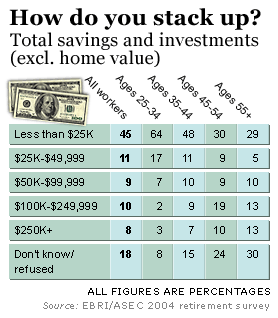
NEW YORK (CNN/Money) � Few things are more satisfying than a job well done.
But I wouldn't know.
Judging from the 2004 retirement survey by the Employee Benefit Research Institute (EBRI) and the American Savings Council (ASEC), I and other personal finance writers might reconsider just how well we're serving you.
That's because part of our job is to write about why it's important to save for retirement, how to put money away in relatively painless ways, smart portfolio strategies, you name it.
But, looking at the results of the EBRI/ASEC survey, I'm beginning to feel like writing about retirement is as effective as raking leaves in the wind. It seems futile.
I say that because since 2001, the number of U.S. workers who say they are currently saving for retirement hasn't grown. Only 6 out of 10 of us are currently setting aside money for tomorrow.

And the savings we have aren't exactly tempting the evil eye. The survey found that 45 percent of all workers reported total household assets, excluding their homes, of less than $25,000.
So why aren't our nest eggs bigger? There may be lots of external factors, including prolonged unemployment for some workers and the after-effects of a wicked bear market. Fair enough.
But it's also true to say that most of us (and you know who you are) remained gainfully employed over the past few years. And while the bear market was harrowing, some investors limited their pain by staying well diversified and continuing to save and invest when the market was scraping bottom.
Other reasons for shrinking savings
Something else is likely to be at work, too.
Our low savings levels in part may be due to the fact that a lot of us are laboring under false notions about how much money we need to finance a retirement � which for many of us will not include a company-paid pension with health benefits.
According to the survey, 10 percent of workers think they will need less than 50 percent of their pre-retirement income to live comfortably in their golden years; another 28 percent think they'll need somewhere between 50 percent and 70 percent.
| ANOTHER WAY TO LOOK AT SAVINGS
|

|
|
|
|
What's more, 6 out of 10 workers said they do not expect their standard of living to decline, while nearly 5 out of 10 workers who have not saved at all feel at least somewhat confident about their ability to have a comfortable retirement.
Now I need an Advil. Maybe my next column should be about logical reasoning.
To be fair, these respondents didn't get to confer with the retirees who took the survey: 39 percent of them said they're drawing an income that's the same as their pre-retirement income; while 13 percent said their current income is actually higher.
At the very least, retirement experts recommend you plan to live on 70 percent of your pre-retirement income.
But you might plan on more if you don't have a pension, if there's a good possibility you'll have big medical expenses in retirement, or if you plan to lead an active lifestyle that will include pricey activities such as travel or education. (I don't know about you, but given a little free time I have no problem finding ways to spend money.)
And maybe many respondents felt savings weren't critical to achieving a comfortable retirement because two-thirds said they expect to work for pay in retirement. That's a fine idea, but what if you're unable to work in retirement? What's Plan B?
Here's Plan B
Making even a rough estimate today of what you'll need years from now can have a positive effect on your savings habits. (For help, try ASEC's Ballpark Worksheet and other tools or CNN/Money's retirement planner.)
Forty-two percent of respondents said they'd done just that. Of those, 43 percent said they made changes in their planning as a result. Those changes included saving more, changing how their money was allocated, reducing debt and saving for the first time.
 |
YOUR E-MAIL ALERTS
|
Follow the news that matters to you. Create your own alert to be notified on topics you're interested in.
Or, visit Popular Alerts for suggestions.
|
|
|
Good moves all. Debt is a top deterrent to savings and so is a zero-percent savings rate. Diversifying your investments can give you better shot at dining with the bulls, beating off the bears and keeping a liquid stash at the ready.
And boosting your savings is one of the best ways to feather your nest egg. No matter how well you allocate your portfolio and no matter how fortunate you are in the stock and bond markets, the compounding on a little bit of savings � while impressive � won't yield nearly as much as the compounding on a little bit more.
Am I still beating my head against a wall?
Jeanne Sahadi writes about personal finance for CNN/Money. She also appears regularly on CNNfn's "Your Money," which airs weeknights at 5 p.m. ET. Please let her know what you think about this or other columns by e-mailing her at everydaymoney@cnnmoney.com.

|

